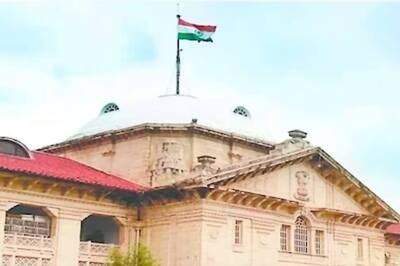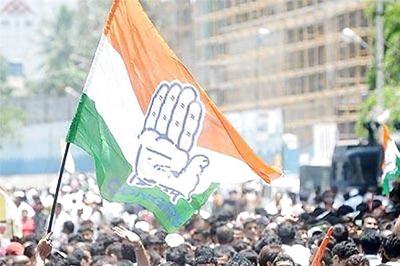
views
The Shiv Sena is known for its aggression, unruly behaviour and violent campaigns against the South Indians, communists, Muslims, Biharis and North Indian residents but prospects of a Sena-NCP alliance is prompting the Congress to consider a coalition government. Even as discussions are underway, several arguments are being marshalled within the Congress parivar to support the Sena-NCP government.
Sena has no formal ties with the Rashtriya Swayamsevak Sangh (RSS), Jan Sangh, Hindu Mahasabha or Vishwa Hindu Parishad. Accused of instigating several riots in Maharashtra, including the Mumbai riots of the late 1960s, the Bhiwandi riots in 1984 and the Mumbai riots of 1992-93, Shiv Sena has been a proud practitioner of its radical Hindutva ideology laced with parochial objectives.
This aspect of Sena’s past is causing acute discomfort to the Congress leadership. While ‘Kerala Lobby’ within the Congress (read A K Antony-KC Venugopal) may be cautioning Sonia Gandhi against backing Sena, the AICC’s interim chief is under pressure from its newly elected MLAs to extend support to government formation bid by Sena-NCP combine. Congress MLAs camping in Jaipur want party leadership to initially extend support from outside, stake claim on Speaker’s post and then negotiate ministerial berths. In their collective wisdom, participation in ministry cements alliance and brings stability while support from outside tends to be tentative, problematic and does not even offer a fig-leaf in terms of showcasing party’s reluctance to get into the alliance.
Sitting in Jaipur, Maharashtra Congress MLAs point at the past to highlight Shiv Sena and Balasaheb Thackeray’s rise in Maharashtra. According to them, it is a story of how the Congress, which excelled in propping up regional players to settle its own regional satraps, used and manipulated Thackeray and his nascent party to ‘fix’ Morarji Desai, Krishna Menon and a range of other players.
In her biography of Thackeray, ‘Hindu Hriday Samrat: How The Shiv Sena Changed Mumbai Forever’ (HaperCollins), author Sujata Anandan has meticulously recorded how Shiv Sena was called ‘Vasant Sena’ after Congress chief ministers like Vasantrao Naik and Vasantdada Patil provided the Sena credibility by accepting its agenda of accepting 80 per cent employment of locals in business establishments. Both Naik and Patil had detested dominance of Gujarati, Parsi, Sindhi and Bohra Muslim enterprises in Mumbai and Maharashtra. Thackeray played his role as the Congress’s ‘hit man’ till -- just like Jarnail Singh Bhindranwale in mid-1980s Punjab -- he became a cult figure of his own.
One such election where the Shiv Sena helped out the Congress was in 1967 during the Lok Sabha polls. Congress stalwart V K Krishna Menon had been denied a party ticket and was contesting as an independent candidate from the Bombay North East constituency and campaigning on the plank of his proximity to Jawaharlal Nehru.
His election campaign posters read ‘Nehru’s vision, Menon’s mission’ and showed Menon within a Nehru silhouette. Indira Gandhi, who was fighting to isolate Menon, instructed her key aides to get the former defence minister defeated at ‘all costs.’ Thackeray, the Shiv Sena and Marmik swung into action, campaigning for the Congress nominee S G Barve. A day before the votes, Marmik published a cartoon that showed Menon with two foreign girls with his hands around their shoulder. The caption insinuated that they were the reason why Menon wanted to be defence minister. Barve won the election.
Thackeray, whose cartoon-making style was influenced by David Low, was reportedly denied a promotion allegedly by a ‘South Indian clique’. He left his job to start a political satire weekly Marmik which culminated in the launch of the Shiv Sena. Marmik used to highlight the recruitment of non-Maharashtrians in both government and private industries under the headline 'Vaacha ani gappa basa' or ‘read and keep quiet’. Soon, South Indians were targeted with the war cry ‘Bajao pungi, bhagao lungi’ coined by Thackeray. This perhaps explains why Congressmen A K Antony and K C Venugopal still have reservations about Congress joining hands with Sena. [cited in my book, ‘Ballot-Ten Episodes That Shaped India's Democracy’ Hachette 2018]
Many Congress old-timers remember how the Shiv Sena had supported Indira Gandhi’s Emergency. In an editorial in Marmik on 31 August 1975, Balasaheb Thackeray wrote that imposing Emergency was the only alternative to handle the situation created after unrest. Similarly, in the 1980 assembly elections, the Sena did not field any candidates against the Congress. Abdul Rahman Antulay, a personal friend of Thackeray, served as the Congress chief minister from 1980 to 1982, when he promised to bring back warrior-king Chhatrapati Shivaji Maharaj's legendary 'Bhavani' sword back from the United Kingdom, where it was believed to be housed in the British Museum. As a minister in P V Narasimha Rao’s cabinet in the 1990s, Antulay stunned Congressmen by declaring himself a ‘Shiv Sainik’ and urged an interviewer not to address him as ‘Abdul Rahman’, preferring he be called A.R. Antulay as it glossed over his religious identity. Shiv Sena had also supported the Congress’ presidential nominees Pratibha Patil and Pranab Mukherjee in 2007 and 2012 respectively.
When Balasaheb Thackeray died on November 17, 2012, Congress-NCP government in Maharashtra accorded a state funeral, which entails taking the deceased’s body draped in the tricolour in a procession on a gun-carriage with police or army escorts, besides a 21-gun salute ahead of the funeral. It is an honour reserved for those who have held constitutional posts such as prime ministerships, but the Congress chief minister of Maharashtra of the time, Prithviraj Chavan, ordered one for Thackeray, disregarding murmurs from within the Congress and dismissing criticism by saying he was responding to the ‘public sentiment’.
Chavan is back in the reckoning, seen in some quarters as a suitable contender for Speaker’s post. The former state chief minister who is an MLA from Karad, is passionately battling for public sentiment in favour of Sena-NCP government supported by the Congress. Then, of course, there is a long list of Congress leaders who came from Sena (including Sanjay Nirupam) who went on to hold high offices and positions in the grand old party.
In sum and substance, pressure is on Sonia Gandhi to give a go ahead.
(The author is a visiting Fellow with the Observer Research Foundation. Views are personal.)




















Comments
0 comment